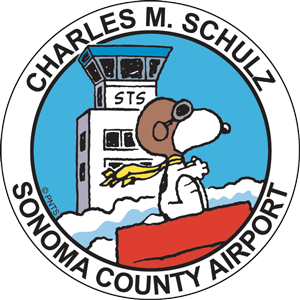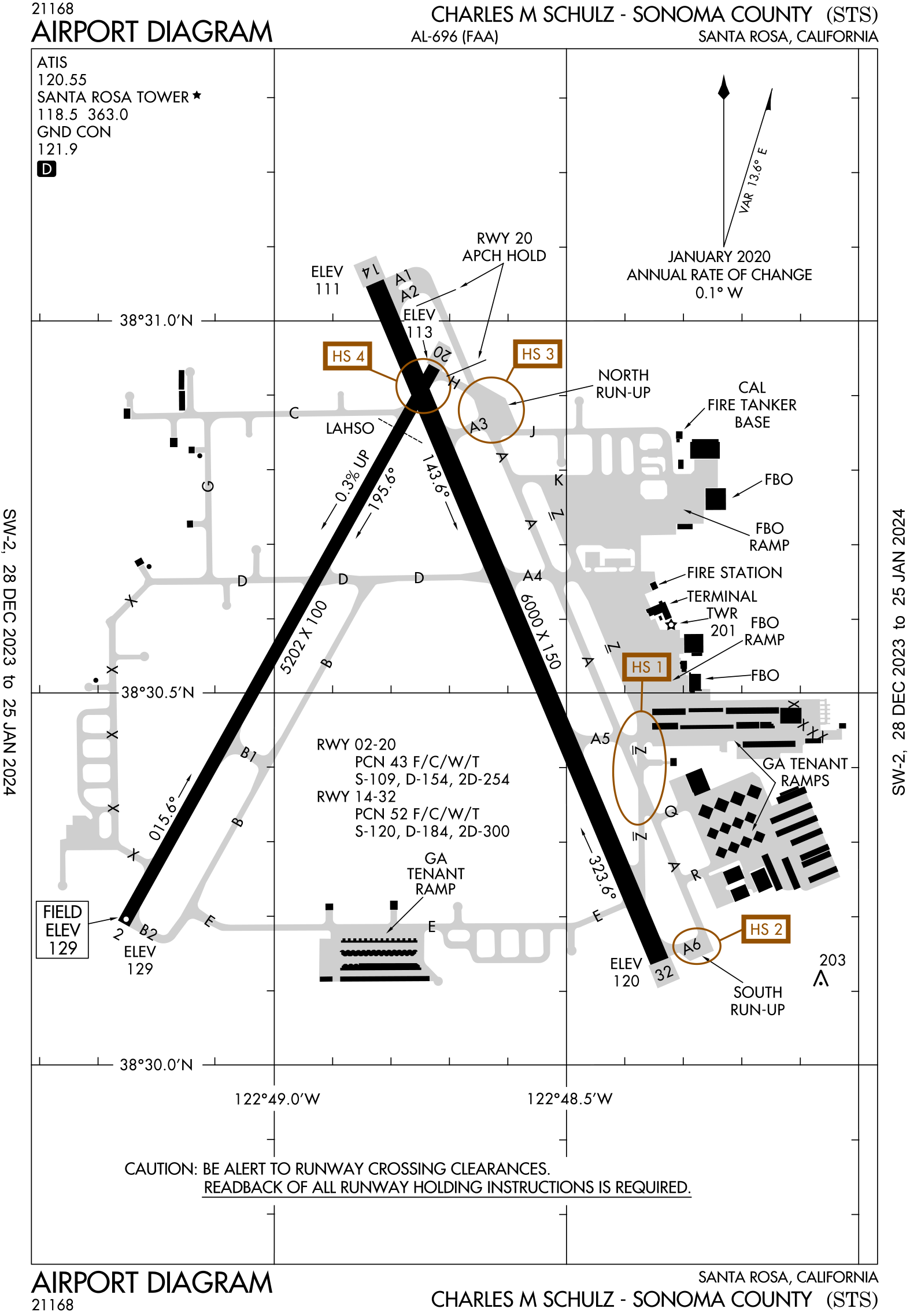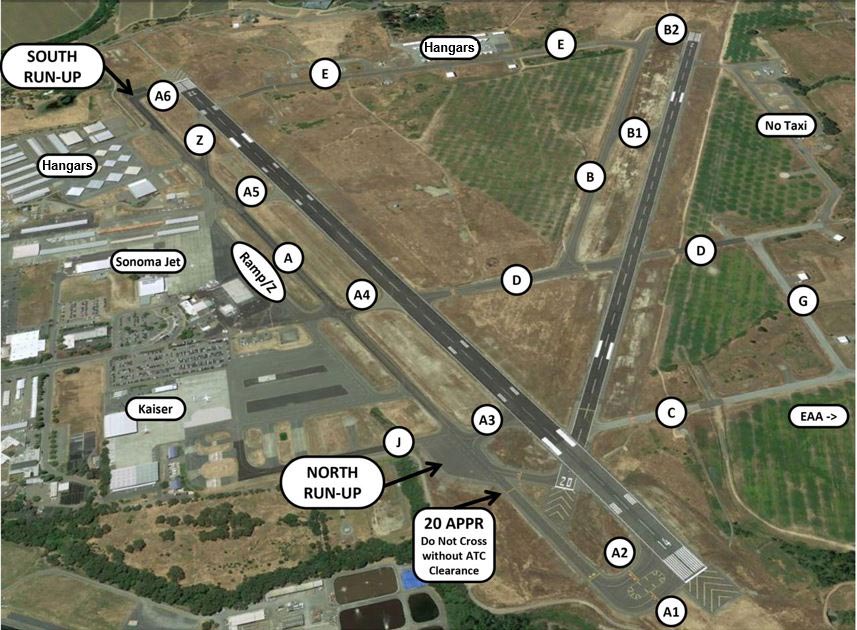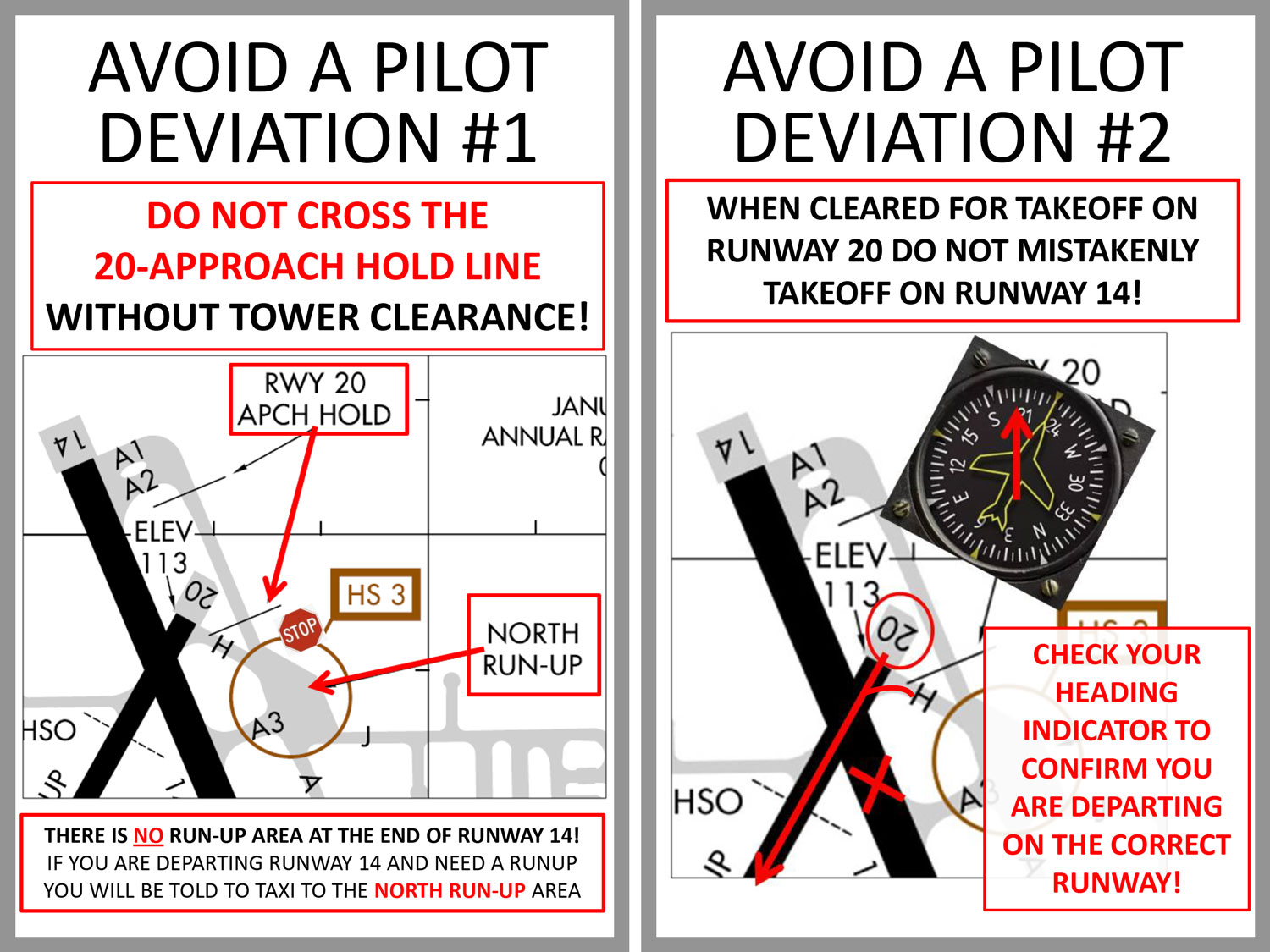Pilot Information
Traffic and Frequencies
Air Traffic Control
Operating hours: 7 a.m. to 8 p.m. local time
(1500-0400Z)
Frequencies
Ground Control 121.90 (0700-2000 local)
CTAF 118.5 (When ATCT is closed after 8 pm and before 7 am local time)
UNICOM 122.95
ATIS 120.55 (707-545-ATIS)
Oakland Center 127.80
During periods of Daylight Savings Time effective hours will be one hour earlier than shown.
Runways and Lighting
Runways
The Charles M. Schulz-Sonoma County Airport (STS) is open to the public and located 6 miles northwest of Santa Rosa, CA at an elevation of 128.7 ft. The Airport has two paved runways, with the main runway designated as Runway 14-32 and the secondary runway as Runway 2-20.
Runway 14-32
The published dimensions are 6,000 feet long by 150 feet wide. The runway is capable of handling aircraft weighing up to 184,000 pounds maximum gross certified takeoff weight (MGTOW). Runway 14 is equipped with a 4-light Precision Approach Path Indicator (PAPI). Runway 32 is equipped with a precision instrument landing system and a medium-intensity approach light system (MALSR). This runway is also equipped with High-Intensity Runway Lights (HIRL).
- Dimensions: H6,000 X 150 ft. / 1,829 X 46 m
- Surface: Asphalt/Grooved, in good condition
- Runway 14 : PAPI (P4R) – GA 3.0° TCH 49 ft. Trees
- Runway 32: MALSR. Trees.
- Weight limitations: S-120,000 lbs, D-184,000 lbs, DT-300,000 lbs
- Runway edge lights: high-intensity
Runway 14 / Runway 32
- Traffic pattern: right / left
- Markings: precision instrument / precision instrument
- Markings condition: good / good
- Elevation: 110.6 ft. / 120.5 ft.
- Visual glide path angle: 3.00 degrees / NA
- Visual slope indicator: 4-light PAPI on right / NA
- RVR equipment: NA / touchdown RWY 32
- Approach lights: NA / MALSR: 1,400 foot
- Instrument approach: GPS; VOR/DME / ILS; GPS; VOR/DME
- Displaced threshold: no / no
- Touchdown Point: yes / yes
- TD elevation: 119.7 ft. / 122.3 ft.
- TD lights: no / no
- Obstructions: TREES / TREES
Runway 2-20
The published dimensions are 5,202 feet long by 100 feet wide. Its use is limited to aircraft weighing less than 154,000 pounds MGTOW. Runway 2 is equipped with a 2-light PAPI on the left and Runway 20 has a 4-light PAPI on the left. The runway has non-precision markings and is equipped with Medium-Intensity Runway Lights (MIRL).
Dimensions: H5202 X 100 ft. / 1,585 X 30 m
Surface: Asphalt/Grooved, in good condition
Runway 2: PAPI (P2L) – GA 3.0° TCH 50 ft. Trees.
Runway 20: PAPI (P4L) – GA 3.5° TCH 48 ft. Trees.
Weight limitations: S-109,000 lbs, D-154,000 lbs, DT-254,000 lbs
Runway 2 / Runway 20
- Traffic pattern: left / left
- Markings: basic / basic
- Markings condition: good / good
- Elevation: 128.6 ft. / 113.4 ft.
- Visual glide path angle: 3.0° / 3.5°
- Visual slope indicator: 2-light PAPI on left/ 4-light PAPI on right
- Runway end identifier lights: no / no
- Centerline lights: no / no
- Instrument approach: GPS / NA
- Displaced threshold: no / no
- Touchdown Point: yes / yes
- TD elevation: 128.5 ft./ 116.5 ft.
- TD lights: no / no
- Obstructions: TREES / TREES
Lighting
- Rotating Beacon : White-Green (lighted land airport) Sunset to Sunrise
- When tower closed activate MALSR Runway 32; PAPI Runway 2, 20, and 14; HIRL Runway 14/32; MIRL Runway 2/20; Taxiway lights via CTAF
- Land and Hold Short Operations may be available for landing Runway 2, contact tower.
*** NOT FOR NAVIGATION. Please procure official charts for flight. ***
Pilot Deviations
Avoid a Pilot Deviation #1
- Do NOT cross the 20-approach hold line without tower clearance!
- There is NO run-up area at the end of Runway 14! If you are departing Runway 14 and need a run-up, you will be told to taxi to the North Run-Up area.
Avoid a Pilot Deviation #2
- When cleared for takeoff on Runway 20, do NOT mistakenly takeoff on Runway 14!
- Check your heading indicator to confirm you are departing on the correct runway!
Weather
ASOS (Automated Weather Observation): (707) 573-8393
Temperature Conversions
Celsius to Fahrenheit Temperature:
(C Temp X 9/5) + 32) 20C: (20X9/5) + 32 = 68F
Fahrenheit to Celsius Temperature:
(F Temp – 32) X 5/9) 68F: (68-32) X 5/9 = 20C
Wildlife Protection
Protect Seabirds and Mammals
Seabirds
Marine Mammals
To prevent wildlife disturbance
- Remain at least 2,000 AGL when flying within ¼ mile of the coast over offshore rocks and islands or within California National Marine Sanctuaries. Flying below 1,000 feet AGL is prohibited in specific zones along the California coast and offshore in order to protect wildlife.
- Flying motorized aircraft at less than 1,000 feet is prohibited over waters within one nautical mile of the Farallon Islands, Bolinas Lagoon, or any Area of Special Biological Significance as designated by the State of California.
- Avoid sudden changes in direction, altitude, and speed near coastal nesting areas and marine mammal colonies.
- If birds or marine mammals are observed fleeing or reacting to your presence, vacate the area.
- Report wildlife disturbances caused by low-flying aircraft to the NOAA Enforcement Hotline: 1-800-853-1964.
For more information, please read or contact:
Need Accessibility Assistance?
The Charles M. Schulz – Sonoma County Airport website is designed, developed, and maintained to comply with California Government Code Sections 7405, 11135, and Web Content Accessibility Guidelines (WCAG) 2.0 AA and AAA whenever feasible based on content. This website is a living project, evolving and improving over time. We will continue to work to improve the accessibility of our website to ensure it complies with the best practices and standards defined by Section 508 of the U.S. Rehabilitation Act, the World Wide Web Consortium’s Web Content Accessibility Guidelines and any issues encountered by web users. Thank You.
If you encounter an accessibility problem, please email us at: stscomments@sonoma-county.org



